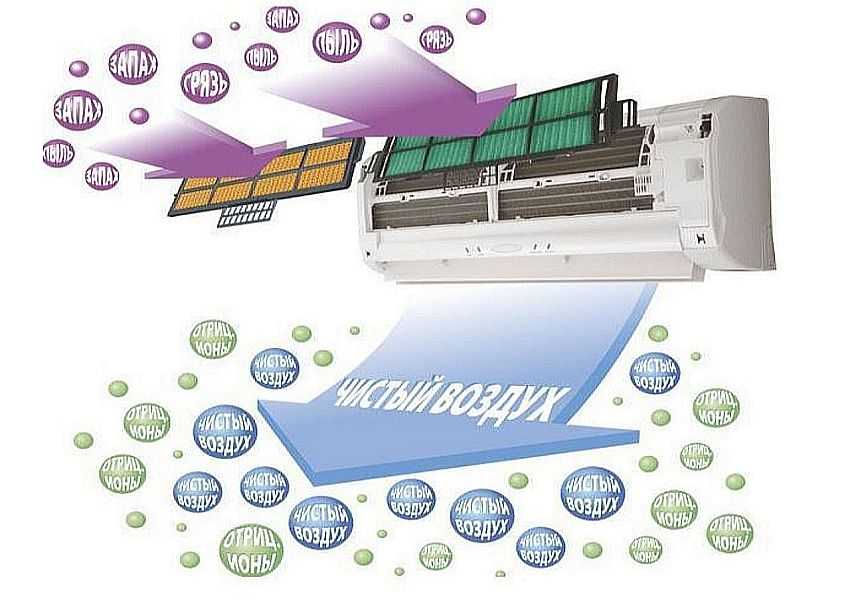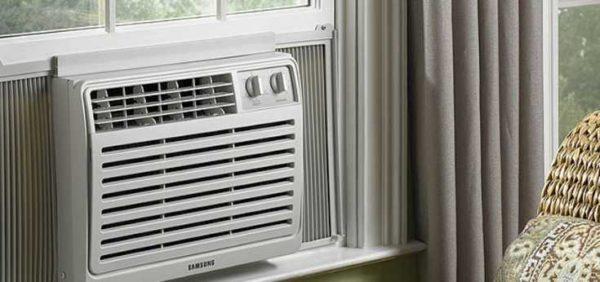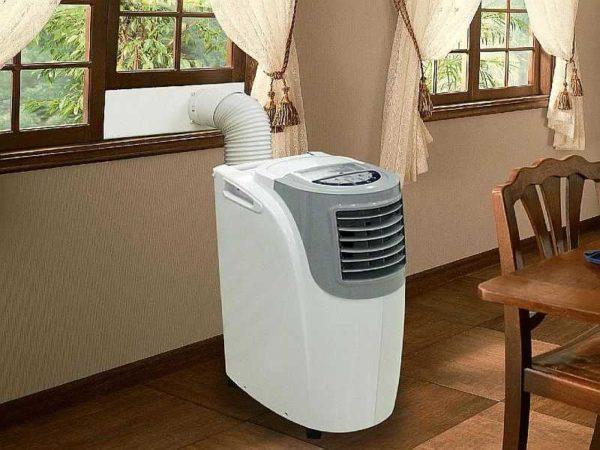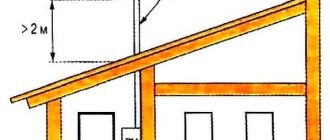Summer is a wonderful time, but the heat is not always pleasant. Climate engineering allows to increase the comfort of life – it will keep the temperature within the normal limits and can adjust the humidity. But it is not so easy to choose a conditioner: there are too many offers on the market. How not to make a mistake when choosing, but also not to overpay?
When it comes to cooling the air in the room two terms are used – air conditioners and split-systems. What is the difference? Air conditioners are a common name for cooling and ventilation systems. Including so called and monoblock (from one unit) – window and mobile (mobile) devices. A split system is a specific type of equipment consisting of two or more units – outdoor and indoor (several indoor units).
Article content
Types of air conditioners
A little about what air conditioners for a house or apartment are. There is a classification by the number of blocks. It can be considered the main one.
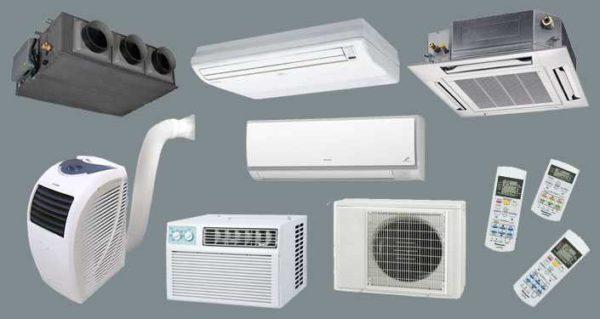
Monoblock
In monoblock air conditioners all parts and devices are packed in one case. This type of climatic technique appeared first and was once widespread, but today there are not so many of them – they are too noisy.
According to the method of installation, monoblock air conditioners are:
- Window – installed instead of part of the frame. In recent years, such units have lost their former popularity – they are very noisy, cover part of the window, and the appearance is not the most attractive. Advantages: this is the most budget option, which has productive cooling. Not a bad economy-option for a cottage, office or small industrial premises.
- Mobile floor air conditioners. This is a rather massive case on four wheels. Although these models are mobile, they are also tied to a window or ventilation system: the exhaust hot air is discharged there with the help of a corrugated hose. That is, it will be necessary to provide in the window some kind of insert with a hole of suitable size – to be able to lead the corrugated hose outside. The advantage – a relatively low price and ease of installation. Organize the exhaust air outlet – this is the whole installation. Then you turn it on and it works. If desired, you can take it to another room (if there is a place to connect the hose).
Cooling systems from several blocks
These climate systems are more modern, have a wider functionality, work quieter (due to the fact that the most noisy devices are moved outside – outside the room). There are several types of such equipment:
In domestic split systems (and “multi” too), the internal units can be of three types: wall-mounted, ceiling-mounted, floor-mounted. Of all three options is the most popular wall-mounted, although the ceiling is more effective, as it more evenly distributes the flows throughout the room, without creating sharp contrasting zones in temperature.
There are also split systems channel, cassette, floor-ceiling, column. But all of them are characterized by high performance and complexity and are used in enterprises and large offices. In houses and apartments they are installed very rarely.
If you have to choose an air conditioner in a house or an apartment, you will have to limit yourself to four variants – window, mobile floor or split-systems of two types – with one or several internal blocks. Although, recently, the vast majority of people choose split systems, as they can provide a higher level of comfort.
Deciding on the capacity
Deciding on the type of equipment is not everything. Further it is necessary to understand the technical characteristics, choose the necessary options, and only then proceed to the choice of a particular model.

Let’s understand what capacity of the cooling system you need. There are two ways to find out the necessary capacity of the air conditioner: to call a representative of the company that sells air conditioners or to calculate it yourself. The calculation itself is elementary, but you will have to take into account the peculiarities of your house or apartment.
Calculation by square meter
So, when determining the power of the air conditioner, it is considered that 10 square meters of area requires 1 kW of cooling power. That is, if you plan to install a split system only for cooling the room, find its area, divide by 10 and get the desired performance.
But, sometimes, it is worth the found figure to increase: if the house in which you live panel or brick, without additional insulation, its walls in the summer will be noticeably heated. In order for the equipment to cope with such a load without problems, it is worth adding 20-25% of the found power. Then there will be no problems with the temperature even on the hottest days.
For example, a room of 22 square meters. Divided by 10, we get 2.2 kW. This is the power or a little more we are looking for when selecting a model.
The same principles are true for calculating the power of equipment for the entire apartment or house. Only the area of all rooms in which you plan to maintain the required microclimate with the help of this air conditioner is summarized. And after that everything is the same: divide by 10, add a reserve if necessary.
Calculation by volume
This method is more accurate, as it also takes into account the height of ceilings, as well as the peculiarities of the location of rooms. Calculated in this case as follows: the volume of the room is multiplied by the norm, and then make a correction for other sources of heat. The norm is as follows:
- for rooms facing north – 30 W/m3;
- if the walls face west/east – 35 W/m3;
- if the wall faces south – 40 W/m3.
In a corner room, a higher standard is chosen. Also higher power is necessary if the window area is large or if there are old wooden frames that do not provide air tightness.
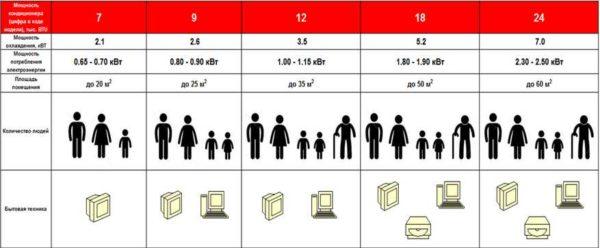
Additional sources of heat for air conditioning are considered:
- Computer. If it is installed in the room, add 300-400 W to the figure found.
- Person. In general, this position is more often used when calculating the parameters of air conditioning in offices and industrial premises, but in a “densely populated” apartment can also be important. For each person in the room add 100-150 W of air conditioner power.
Here is an example of calculation. It is necessary to choose an air conditioner for a south-facing room where a computer is installed and one person lives permanently. The room dimensions are 4*3,5*2,7 meters. We find the volume, multiply all parameters of the room and get 37,8 m3. The found figure is multiplied by the norm: 37,8 m3 * 40 W/m3 = 1512 W. Then let’s add a reserve for external heat sources: 1512 W + 400 W + 150 W = 2032 W. Rounding off, we get 2000 W or 2 kW.
Basic technical characteristics
In order to choose a conditioner correctly, it is necessary to know the main characteristics showing its efficiency and economy. You can do without these technical subtleties, but you will have to rely on the advice of a sales-consultant, and they are not always objective. Therefore, it is better to understand yourself, especially since it is not very difficult.
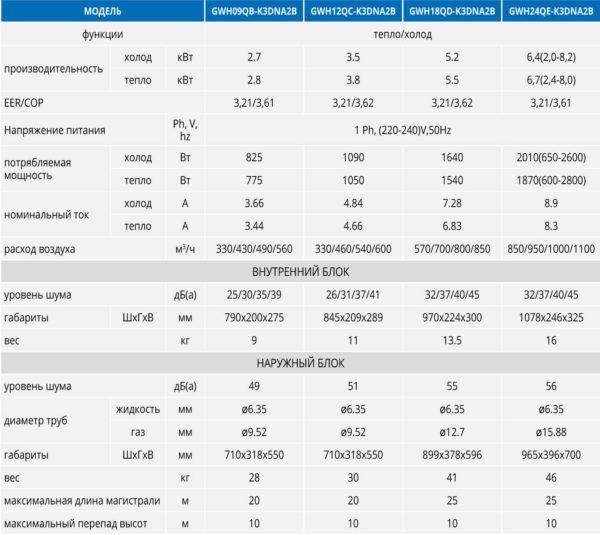
Cooling class or cooling capacity
In the technical specifications of air conditioners and split systems you can see a line where it says “cooling capacity”, and then there are numbers from 5200 BTU/hour to 42700 BTU/hour. Let’s break it down. BTU/hour is a British thermal unit and it displays the amount of energy the unit will use to raise the temperature of 1 pound of water by 1 degree Fahrenheit.
In relation to air conditioners, this parameter reflects cooling efficiency. The higher the cooling capacity (more numbers), the more economical the split system will be (less electricity costs will be incurred).
Sometimes instead of cooling capacity the cooling class is indicated, and then there are Latin letters A, B, C, D, E, F, G. This parameter also reflects the efficiency of operation, but it is considered as a ratio of heating power to the consumed power. It is also denoted as ERR or SERR.
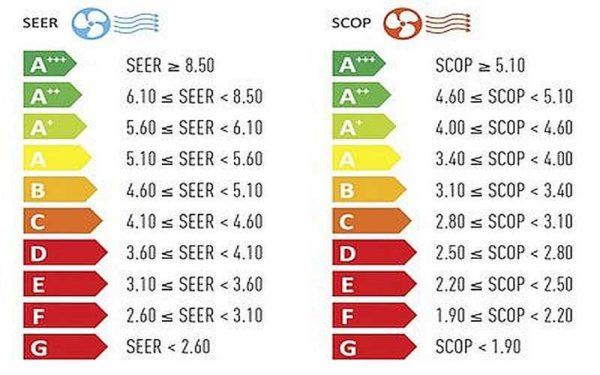
If we talk about the letter designation, class A is the most economical, class G – spends the most electricity. As a rule, all other characteristics being equal, household appliances of class A and above (there are also A+, A++, A +++) are more expensive. The difference is hundreds of dollars. Earlier, when electricity was not so expensive, few people paid attention to this indicator – the difference expressed in rubles was not so great. Now, when the price for electric power is constantly growing, it is probably worth buying a more economical conditioner – at certain time intervals it can work for twenty-four hours, so this parameter is quite important now.
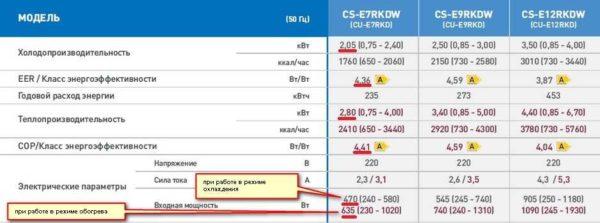
There is also a second coefficient – COP or SCOP. It reflects the efficiency of heating, defined as the ratio of the amount of heat released to the amount of energy consumed. Naturally, the same rule applies in this case: the higher the coefficient is, the more economical the air conditioner will be during heating operation (if such function is available).
Noise level
Two values are usually indicated in characteristics – maximum and minimum noise level. It is measured when working at minimum and maximum power.
An important characteristic, especially if the split system will be installed in the bedroom. In this case, look for a very quiet air conditioner. For a bedroom, a noise level of 19-24 dB will be acceptable. The maximum permissible level in residential premises according to SNiP is 34 dB, so those that do not fit this criterion it is better not to consider.
Maximum length of communications
Split systems consist of two or more units and between them they are connected by means of ducts and wiring harnesses, through which control signals are transmitted.
In the standard version, the length of the duct is 5 meters, which is usually enough. But when installing in large private houses or cottages, greater distances may be required. The maximum length of communication is 42 meters. Such models cost much more, as well as payment for their installation. To choose a conditioner according to this principle, you will have to first at least approximately determine its location (internal and external units), measure the expected distance (take into account that the route runs along the walls) and only then choose a model.
Additional functions
It is impossible to choose a conditioner and not to think about additional functions. They allow to increase the level of comfort, but the presence of each function increases the final cost of the equipment. That is why it is necessary to approach the choice in a balanced way.
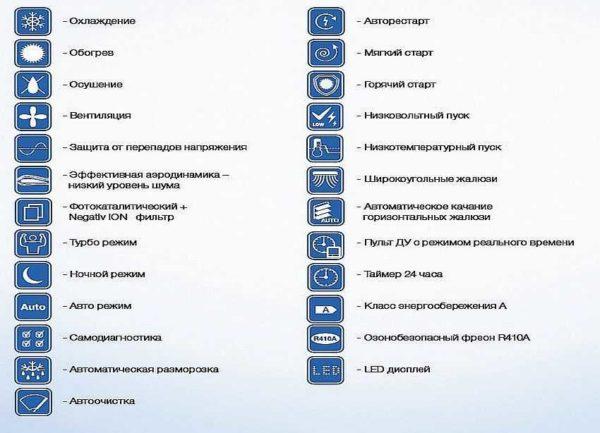
Availability of remote control
Today, probably, all models of split systems come with a remote control. It is understandable – the blocks usually hang under the ceiling and go up there every time as it is necessary to change the mode of operation is unlikely to like anyone. So it is difficult to call it an additional function, but there are also models without remote control, so be careful. To choose a conditioner and then to realize that there is no remote control is not a good opening.
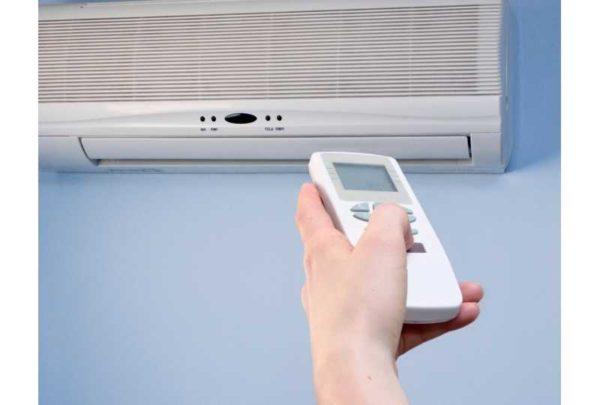
Remote control allows to change all parameters of air conditioner and split system operation:
- temperature;
- fan rotation speed;
- air flow direction (vertical and horizontal position of the curtains is changed).
This is the minimum set, there can be a whole range of functions, but in case the model supports them.
Automatic mode
Useful option. Allows you to set the desired temperature, and in some models, and humidity, and forget. Then the split system itself will turn on and turn off when the parameters deviate from the set parameters.
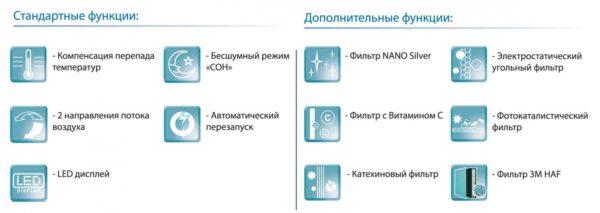
Such equipment is much more convenient and economical than the one that should be switched on and off forcibly from the remote control.
What is the difference between an inverter air conditioner
Inverter air conditioners are air conditioners that can change smoothly the parameters of work: cooling power and speed of fans. Unlike conventional technology, when the equipment has two modes of operation: either it works at 100% capacity or is switched off. This gives three undeniable advantages:
If you need to choose an economical air conditioner in an apartment or house, you should look at inverter models. Though they are more expensive than usual ones, they “wash” less electricity (the saving can reach about 30%).
Another advantage of inverter air conditioners is a wider range of operating temperatures. Some models can work at -35°C, and the upper limit is also higher – up to +45°C. This may be important in some regions.
Heating mode
There are air conditioners that can work not only for cooling, but also for heating. This function is useful in apartments connected to centralized heating. If necessary, it is possible to heat in the off-season, when it is already cool outside, but heating is not turned on yet. In this case conditioner with heating is a very necessary thing. Such mode is sometimes called “winter/summer”.
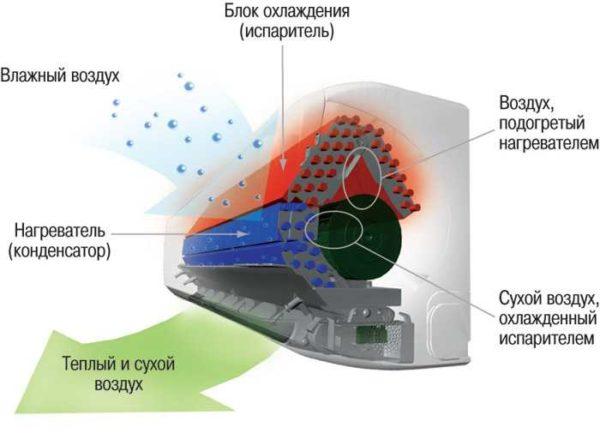
If your choice has fallen on a model with a possibility to work on air heating, pay attention to two parameters in technical characteristics: capacity in cooling mode and capacity in heating mode. In cheap models, they are unequal and can show from 20% to 60% of cooling. That is, such models will not provide you with full-fledged heating. In more expensive models, the percentage ratio looks better, in some even reaches 100%. But they belong to the premium class, which is reflected in the cost – they are more expensive by 100-200$.
There is one point: split systems can not work at low temperatures. Most often their working range – up to -5°C. So this is really an option for the off-season. In winter, it simply will not work.
Timer
A useful feature, especially if you are not at home all day. It allows you to turn the air conditioner on or off at a set time. You can set the time of switching on half an hour before your arrival and you will enter the apartment or house with normal temperature.
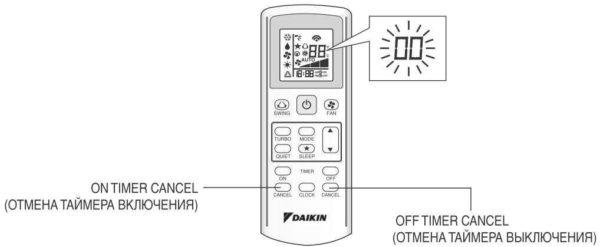
There is also a possibility to turn off the conditioner by timer. This may be necessary in the evening. Automation will turn off the device at the appointed time and you will not have to get up, interrupting your sleep. In general, if you value your own comfort, it is worth choosing a conditioner with this function.
Sleep mode
If the nights are so hot in the region that you can’t turn off the air conditioner at night, the “sleep” mode will be useful. It switches the equipment to the reduced power, fans rotate slower, respectively, the noise level decreases.
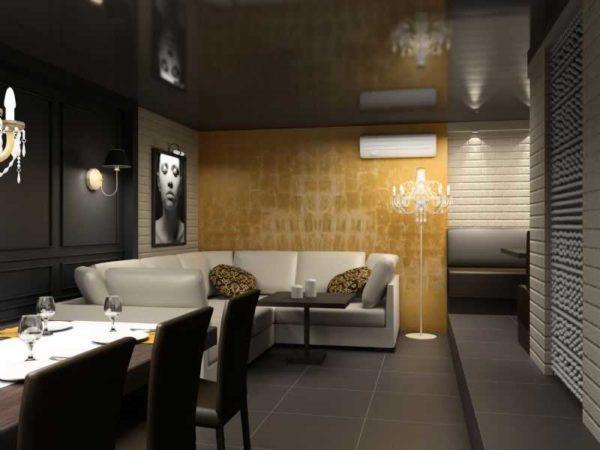
This mode can be useful if the air conditioner is not inverter. In general, not a bad function, but only for those units that you plan to install in the bedroom.
Ozonation and ionization modes
Ozonation and ionization are designed to make the indoor air cleaner, bacteria-free and healthier. The idea itself is good, but there are separate devices for these operations. As usual, special units work more efficiently, and they are rarely used built into the air conditioner, but they raise the cost considerably.

Dehumidification
Dehumidification mode allows to remove excessive moisture from the air, because at high humidity heat is worse tolerated. The function can be useful if you choose a conditioner for a small apartment. In this case the kitchen is not far from living rooms and cooking or even tea can significantly raise humidity in the rooms.
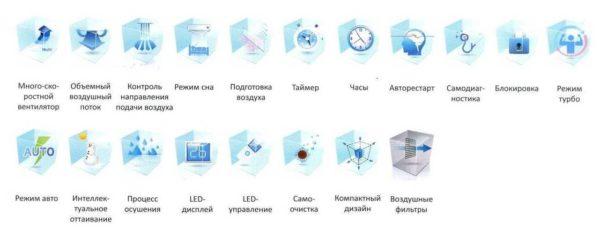
Also this mode is useful in regions characterized by high humidity in the summertime. It allows you to exist in more comfortable conditions.
Ventilation and purification
Ventilation mode (fan in English) is available in many models of split systems. It allows you to “pump” fresh air from the street, but without cooling. Ventilation can occur with different intensity – there can be from 2 to 8 fan speeds. In principle, you can do without this mode, if you have a fanlight, a vent or the ability to open a window.
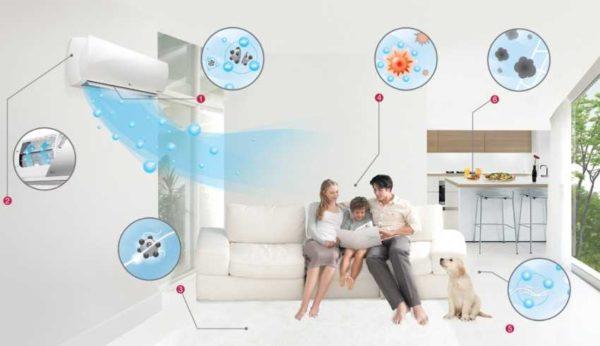
In some models, paired with the ventilation mode, there is purification. The air coming from the street passes through a system of filters, cleansing from allergens and dust particles. This mode is necessary for allergy sufferers, it allows them to survive the worst time with minimal discomfort. So if someone in the family suffers from allergies it is desirable to choose a conditioner with ventilation and purification.
Auto restart
Presence of this function allows to restore the settings that were before power failure. The equipment turns on by itself when the power comes on. This option can be useful if there are frequent power cuts in the region.

